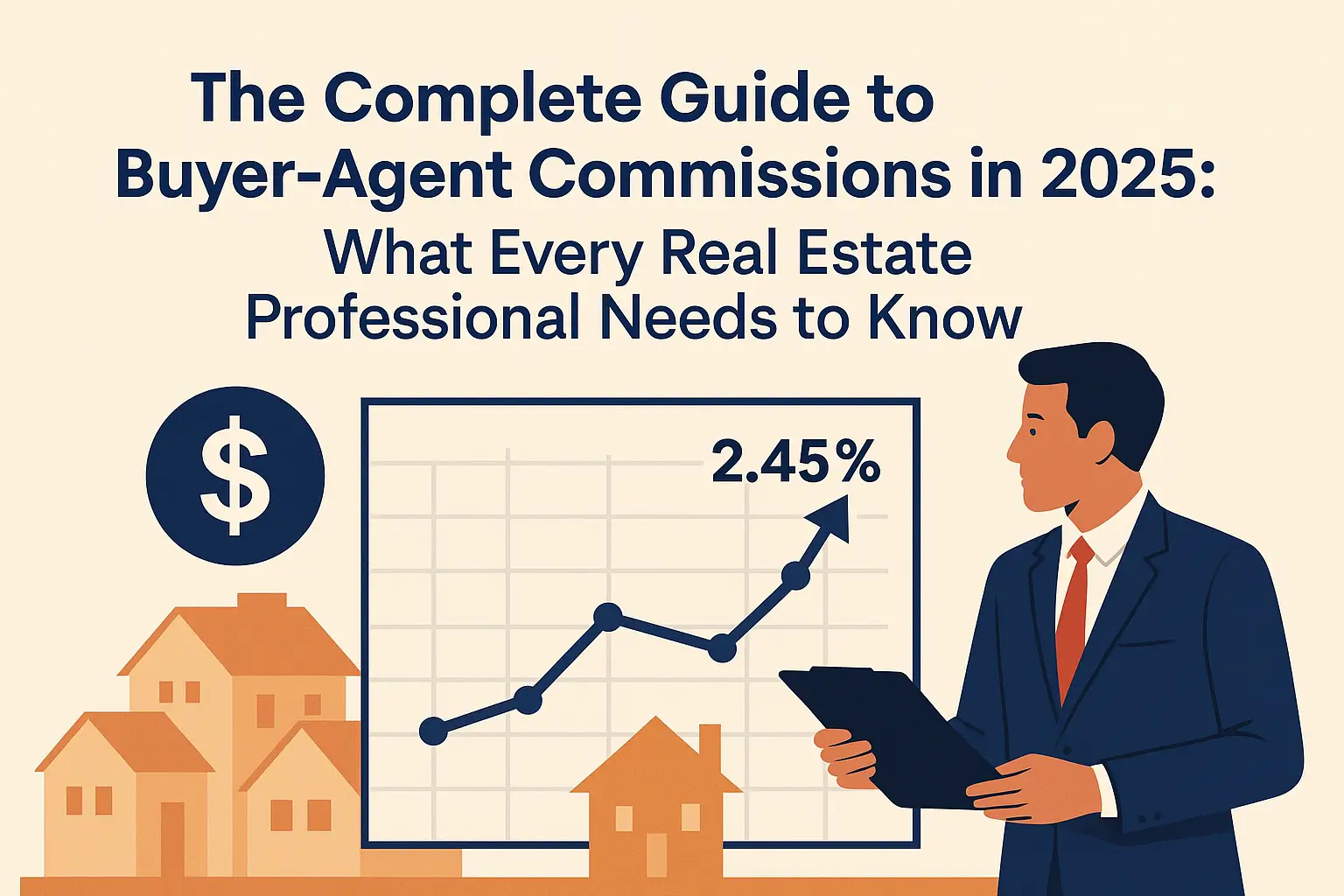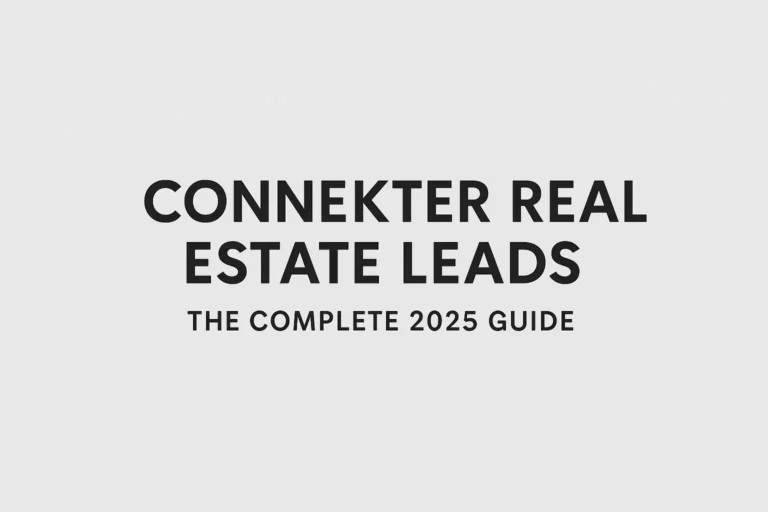The Complete Guide to Buyer-Agent Commissions in 2025: What Every Real Estate Professional Needs to Know
The NAR settlement was supposed to kill buyer-agent commissions. Instead, they’re quietly making a comeback — and if you’re not adapting now, you’re already behind.
While competitors panic about fee negotiations and transparency requirements, smart brokers and agents are capitalizing on a surprising market shift. Buyer-agent commissions have not only recovered from their post-settlement low but are projected to exceed pre-settlement levels by year-end.
Here’s the data that changes everything: Commissions plummeted to 2.36% in Q3 2024 as the industry braced for impact. Nine months later, they’ve surged to 2.43% with clear momentum toward 2.45% by Q3 2025. This isn’t a temporary blip—it’s a fundamental market correction that savvy professionals are already leveraging for competitive advantage.
TL;DR – Key Takeaways:
• Buyer-agent commissions have fully recovered to pre-NAR settlement levels across all price segments
• 85% of transactions still involve seller-paid commissions despite regulatory changes
• Entry-level properties (under $500K) command the highest rates at 2.52%
• Regional variations show opportunities for strategic positioning
• Transparent communication and flexible service models drive success in the new environment
This comprehensive guide reveals the market forces driving commission recovery, provides battle-tested strategies for thriving post-settlement, and shows you how to convert regulatory challenges into competitive advantages.
Buyer-Agent Commission Trends 2025: The Data That Shocked the Industry
NAR Settlement Commission Changes: Recovery Across All Market Segments
[Visual: Interactive Commission Recovery Graph – Q3 2024 to Q3 2025 Projection]
The numbers tell a story that few saw coming. After the NAR settlement created widespread uncertainty, buyer-agent commissions hit their lowest point in Q3 2024 at 2.36%. Industry watchers expected this decline to continue as buyers gained more negotiating power and transparency requirements took hold.
Instead, the market delivered three consecutive quarters of growth. By Q2 2025, commissions had recovered to 2.43%—nearly matching pre-settlement levels. Current projections suggest Q3 2025 will see rates reach 2.45%, effectively erasing the post-settlement dip.
📊 Key Insight: The commission recovery spans all market segments, proving that professional representation value transcends regulatory changes.
This recovery pattern spans all market segments, though with notable variations:
[Visual: Price Segment Commission Comparison Chart]
Entry-Level Homes (Under $500K): Lead the recovery at 2.52% current rates, projected to reach 2.54%. These properties command the highest commissions due to competitive buyer markets and transaction complexity.
Mid-Tier Properties ($500K-$999K): Showing steady growth from 2.26% to 2.34%, with 2.36% projected for Q3 2025.
Luxury Market ($1M+): Maintains the most conservative rates at 2.21% current, expected to reach 2.23%.
Regional Commission Trends in 2025: How Rates Vary Across the U.S.
[Visual: Interactive Regional Commission Map – Austin, Minneapolis, Houston, NYC Metro]
Geographic differences reveal how local market conditions shape commission trends. Austin agents now routinely request 3% commissions, up from the previous 2.5-2.75% range. This increase reflects the city’s competitive buyer market and high transaction volumes.
Pro Insight from the Field: “We’ve actually seen commissions climb back as buyers still value representation when stakes are high,” says Maria Rodriguez, a Manhattan-based broker who manages 15 agents. “In our market, transparency has actually strengthened our value proposition rather than weakened it.”
Minneapolis shows more flexibility, with agents accepting 2.5% rates as buyers negotiate more aggressively. Meanwhile, Houston and Austin face additional pressure from MLS systems that allow non-Realtor access, creating competitive dynamics that force innovation in service delivery.
💡 Key Takeaway: Successful brokers and agents must understand their local market dynamics rather than relying on national averages.
These regional patterns highlight a crucial truth for business growth: cookie-cutter approaches fail in today’s market. Smart brokers are developing location-specific strategies that align with local buyer behavior and competitive landscapes.
Market Forces Driving the Commission Recovery
Who Pays Buyer Agent Commission in 2025: The Seller-Paid Model Endures
Quick Answer for Featured Snippets: Do sellers still pay buyer-agent commissions in 2025? Yes, approximately 85% of transactions still involve sellers paying buyer-agent commissions, though arrangements are now negotiated case-by-case rather than displayed on MLS.
The current market structure has created a paradox. While buyers gained more negotiating power through the NAR settlement, they’re using that power to ensure sellers cover buyer-agent fees rather than eliminating them entirely.
With over 500,000 more sellers than buyers as of June 2025, competition among sellers has intensified. Smart buyers leverage this imbalance by making offers contingent on seller-paid commissions. For sellers, agreeing to cover buyer-agent fees becomes a competitive necessity rather than an optional gesture.
📈 Market Reality Check: This dynamic explains why 85% of transactions still involve sellers paying buyer-agent commissions despite regulatory changes.
Struggling to adjust your commission strategy after the NAR settlement? [Book a free strategy consultation with our real estate growth experts →]
This dynamic explains why approximately 85% of transactions still involve sellers paying buyer-agent commissions. The key difference lies in negotiation timing—these arrangements now happen during offer negotiations rather than through MLS displays.
Real Estate Agent Commission Trends: Why Professional Value Persists
Flat-Fee vs Full-Service Real Estate Agents: What Buyers Actually Choose
Despite regulatory changes, both buyers and sellers continue recognizing professional representation value. This recognition manifests in several ways:
Risk Mitigation: Complex transactions require expertise that saves money and prevents costly mistakes. Professional agents identify issues that could cost thousands later in the process.
Negotiation Skills: Skilled agents typically save clients 2-3% on purchase prices through strategic negotiation. These savings often exceed commission costs, creating clear value propositions.
Market Knowledge: Agents provide insights into neighborhood trends, property values, and timing strategies that DIY approaches can’t match.
Process Management: Transaction coordination, paperwork accuracy, and deadline management prevent delays and legal complications that cost time and money.
💰 ROI Reality: Professional representation often pays for itself through negotiation savings and risk prevention, making commission costs investments rather than expenses.
Case Study Success: Austin buyer Sarah Chen secured a $15,000 price reduction and identified $8,000 in needed repairs through her buyer’s agent—total value of $23,000 against a $9,000 commission investment.
The commission recovery reflects consumers’ continued willingness to pay for these benefits, even in a transparency-focused environment.
Are Sellers Still Paying Commissions After NAR: The New Negotiation Landscape
Quick Answer for Featured Snippets: Are sellers still paying commissions after NAR settlement? Yes, approximately 85% of transactions involve seller-paid commissions, but these are now negotiated during offer discussions rather than pre-displayed on MLS systems.
The elimination of MLS commission displays created significant operational challenges that successful brokers and agents have learned to navigate systematically.
Multiple Negotiation Points: Agents now manage commission discussions at three critical stages—initial buyer representation agreements, offer negotiations with sellers, and potential mid-transaction adjustments. This complexity requires clear communication protocols and detailed documentation.
Workaround Strategies: Many professionals maintain traditional system benefits through phone, email, and direct communication channels. While these approaches require more effort, they preserve established relationships and streamline transactions.
Documentation Requirements: Enhanced paperwork and agreement protocols ensure legal compliance while maintaining professional standards. Successful agents view these requirements as relationship-building opportunities rather than administrative burdens.
Pro Insight from Industry Leaders: According to Jennifer Kim, CEO of Metro Realty Group: “The agents who adapted fastest treated transparency as a competitive advantage. They’re now closing 30% more deals because buyers trust their upfront approach.”
Buyer Education Transforms Resistance into Understanding
Common buyer objections require strategic responses that build trust and demonstrate value:
“We don’t want to pay buyer’s agent commissions after the settlement”: Successful agents explain how seller-paid commissions remain standard in 85% of transactions and help buyers structure competitive offers that include these provisions.
“We want to wait and see if prices come down”: Market education about inventory levels, seasonal trends, and opportunity costs helps buyers make informed timing decisions.
“We’ll just reach out when we see a home online”: Demonstrating the complexity of successful transactions and hidden market opportunities builds appreciation for professional guidance.
Administrative Process Improvements: Mandatory buyer representation agreements before property showings initially created administrative burdens. However, innovative agents have transformed these requirements into trust-building conversations that establish clear expectations and service standards.
5 Proven Strategies for Success in the Post-Settlement Market
Communication Protocols That Build Trust and Convert More Leads
Case Study: How a Brooklyn Agent Used Transparent Fee Structures to Win Three Clients in One Week
Agent Michael Torres implemented upfront commission discussions and flexible payment options during the first week of July 2025. Result: Three signed buyer agreements from prospects who had been shopping multiple agents. His secret: Clear value demonstration before the first property showing.
Successful real estate professionals have developed transparent communication strategies that work within new regulatory requirements while building strong client relationships.
Upfront Fee Discussions: Leading agents address commission structures during initial consultations, explaining payment options including seller-paid, buyer-paid, or hybrid arrangements. This transparency prevents surprises and demonstrates professionalism.
Value Proposition Documentation: Before showing properties, effective agents outline specific services they provide and quantifiable benefits clients receive. This approach transforms regulatory requirements into competitive advantages.
Market Trend Education: Clients appreciate understanding current market dynamics that support professional representation value. Agents who explain these trends build credibility and justify their fees through market intelligence.
🎯 Conversion Tip: Schedule a “Market Strategy Session” before property tours to discuss commission structures alongside market opportunities—this positions fees as investment planning rather than cost discussions.
Flexible Service Models Meet Diverse Client Needs
Downloadable Resource: Buyer-Agent Commission Negotiation Playbook 2025
[Download Free Playbook: 15 Proven Scripts for Commission Conversations →]
Progressive brokerages have developed tiered service packages that address varying client budgets and requirements:
Full-Service Representation: Traditional comprehensive services at standard rates for clients who want complete professional support throughout the transaction process.
Limited-Service Options: Reduced-fee packages for specific services like contract negotiation or closing coordination, appealing to budget-conscious clients with some real estate knowledge.
Flat-Fee Alternatives: Fixed-price services for high-value transactions where percentage-based fees become prohibitive, particularly effective in luxury markets.
Hybrid Arrangements: Customized fee structures that combine elements of different models based on individual client needs and market conditions.
Technology Integration Streamlines Operations and Enhances Value
Smart brokers and agents leverage technology to improve efficiency while demonstrating value to tech-savvy clients:
Digital Agreement Processes: Streamlined buyer representation agreement systems reduce administrative time while ensuring compliance with new requirements.
Real-Time Market Data: Advanced analytics tools help agents provide immediate market insights that justify commission value through superior market intelligence.
Communication Platforms: Enhanced client communication systems keep all parties informed throughout transactions, reducing stress and building satisfaction.
Lead Management Systems: CRM integration helps agents track client preferences, follow up consistently, and demonstrate professional organization that builds trust.
Industry Outlook and Future Opportunities
Regulatory Evolution Continues Shaping Market Dynamics
The Department of Justice maintains active oversight of real estate industry practices, with additional regulatory changes likely on the horizon. Successful professionals prepare for this environment by:
Compliance Excellence: Staying ahead of regulatory requirements through continued education and industry involvement builds credibility and reduces risk.
Transparency Leadership: Embracing transparency as a competitive advantage rather than viewing it as a burden creates differentiation in crowded markets.
Professional Development: Ongoing skill improvement in negotiation, technology, and client service ensures continued value delivery regardless of regulatory changes.
Market Stabilization Creates Strategic Opportunities
Industry analysts expect commission rates to stabilize around current levels through late 2025, creating planning opportunities for forward-thinking professionals:
Business Model Optimization: Stable commission expectations enable long-term planning for service delivery improvements and operational efficiency gains.
Market Positioning: Early adopters of transparent practices and enhanced service models gain competitive advantages as markets stabilize.
Client Relationship Building: Focus on long-term relationship development rather than transaction-focused approaches builds sustainable business foundations.
Technology Disruption Accelerates Innovation
Regulatory changes have accelerated adoption of alternative business models, creating both challenges and opportunities:
Flat-Fee Competition: Traditional agents must clearly demonstrate value advantages over discount competitors through superior service delivery and results.
Technology Integration: Agents who effectively combine personal service with technological efficiency gain competitive advantages over both traditional and discount competitors.
Niche Specialization: Market fragmentation creates opportunities for specialized services in specific property types, price ranges, or client segments.
Practical Implementation Strategies
Lead Generation in the New Environment
Effective lead generation requires adapting traditional approaches to address new market realities:
Content Marketing Focus: Educational content about new processes and commission structures attracts leads while demonstrating expertise and building trust.
SEO Optimization: Local search optimization helps agents capture leads from buyers and sellers researching new requirements and processes.
Social Media Education: LinkedIn and Facebook content that explains market changes positions agents as knowledgeable resources for concerned consumers.
Referral System Updates: Existing referral sources need education about new processes to continue generating quality leads effectively.
Converting Leads into Clients
Lead conversion requires addressing new concerns while highlighting unchanged value propositions:
Process Explanation: Clear explanations of new requirements help concerned leads understand how professional representation benefits them under current rules.
Value Demonstration: Specific examples of recent client savings and problem-solving showcase tangible benefits that justify professional fees.
Competitive Analysis: Helping prospects understand differences between full-service and discount options enables informed decision-making.
Trust Building: Transparency about fees and services builds confidence that leads to long-term client relationships.
Building Authority and Reputation
Personal brand building becomes increasingly important as market transparency increases:
Industry Expertise: Regular commentary on market trends and regulatory changes positions agents as knowledgeable resources for media and referral sources.
Client Success Stories: Case studies that highlight specific client benefits create compelling marketing content while respecting privacy requirements.
Professional Development: Continuing education and industry certifications demonstrate commitment to excellence and current knowledge.
Community Involvement: Local market participation builds relationships and demonstrates community investment that attracts both clients and referral sources.
Frequently Asked Questions
How have buyer-agent commissions actually changed since the NAR settlement?
Buyer-agent commissions have returned to pre-settlement levels after an initial decline. Rates dropped to 2.36% in Q3 2024 but recovered to 2.43% by Q2 2025, with projections reaching 2.45% by Q3 2025. This recovery demonstrates that market forces continue recognizing professional representation value despite regulatory changes.
Do sellers still pay buyer-agent commissions under the new rules?
Quick Answer: Yes, approximately 85% of transactions still involve sellers paying buyer-agent commissions. The key difference is that these arrangements are now negotiated case-by-case through direct communication and documented in purchase contracts rather than displayed on MLS systems. This change increases negotiation complexity but maintains traditional payment structures.
Who pays buyer agent commission in 2025 if sellers refuse?
Quick Answer: Agents can structure offers where buyers pay commissions directly, roll fees into financing through seller concessions, or negotiate alternative arrangements. In competitive markets, sellers often agree to commission payments to attract qualified buyers, as unrepresented buyers can create transaction risks and delays that cost more than commission fees.
What should real estate agents expect from buyer consultation meetings now?
Agents must secure written buyer representation agreements before showing any properties and clearly explain compensation structures upfront. Most successful agents offer multiple options: seller-paid commission (most common), buyer-paid commission, or hybrid arrangements. This transparency actually benefits agents by eliminating surprises and enabling informed client decision-making.
How can agents justify their commissions in this transparent environment?
Successful agents emphasize quantifiable value delivery through specific examples: they typically save clients 2-3% on purchase prices through skilled negotiation, identify potential issues that prevent costly problems, and ensure proper documentation to avoid legal complications. Professional representation often pays for itself through these benefits, making commission costs investments rather than expenses.
Are commission rates different for various property price ranges?
Yes, commission rates vary significantly by price segment. Entry-level homes under $500K command the highest rates at 2.52%, mid-tier properties ($500K-$999K) average 2.34%, and luxury properties over $1M typically see 2.21% commissions. These differences reflect varying complexity levels and risk factors associated with different market segments.
What happens when sellers refuse to pay buyer-agent commissions?
Agents can structure offers where buyers pay commissions directly, roll fees into financing through seller concessions, or negotiate alternative arrangements. In competitive markets, sellers often agree to commission payments to attract qualified buyers, as unrepresented buyers can create transaction risks and delays that cost more than commission fees.
How should buyers approach commission negotiations with their agents?
Buyers should discuss commission options during initial consultations, understand current market trends supporting their negotiating positions, and leverage their strength in high-inventory markets. Successful negotiation often involves requesting seller-paid commissions as part of initial offer strategies rather than separate negotiations.
Are flat-fee or discount brokerages viable alternatives to traditional agents?
Flat-fee brokerages are gaining market share, particularly for high-value transactions where percentage savings become significant. However, buyers should carefully evaluate service levels, as reduced fees often mean limited services that may not suit complex transactions or first-time buyers. The key is matching service levels to transaction complexity and client experience.
What legal protections exist for buyers under the new system?
The new system provides enhanced legal protections through mandatory written agreements that clearly outline services and compensation structures. These agreements provide clearer recourse if service expectations aren’t met and eliminate ambiguity about agent obligations. Enhanced documentation actually improves client protection compared to previous informal arrangements.
How should brokers and agents adapt their business models for long-term success?
Successful adaptation requires embracing transparency as a competitive advantage, developing flexible service packages that meet diverse client needs, demonstrating quantifiable value through specific client benefits, and leveraging technology to streamline processes. Focus should be on education, clear communication, and emphasizing return on investment that professional services provide in today’s complex market environment.
Action Checklist: 5 Things Top Agents Are Doing Right Now
✅ Discuss commission options upfront in buyer consultations Schedule “Market Strategy Sessions” that position fees as investment planning rather than cost discussions.
✅ Offer tiered service packages Develop full-service, limited-service, and flat-fee options to meet diverse client budgets and needs.
✅ Educate buyers on seller-paid commission strategies Leverage the 85% success rate of seller-paid arrangements in current market conditions.
✅ Use transparent value-driven communication Document specific services and quantifiable benefits before showing properties.
✅ Integrate tech tools to streamline negotiations Implement digital agreement processes and real-time market data systems for competitive advantage.
💡 Bonus Tip: Print this checklist and review it weekly to stay ahead of commission trends and market shifts.
Conclusion: Thriving in the New Real Estate Landscape
The buyer-agent commission recovery of 2025 reveals a fundamental truth: professional value endures despite regulatory change. While the NAR settlement created short-term uncertainty and operational challenges, market forces have restored commission levels that reflect the continued importance of expert representation in complex real estate transactions.
For brokers and agents willing to embrace transparency, invest in client education, and demonstrate clear value propositions, the current environment offers significant opportunities. Buyers and sellers still need professional guidance, but they expect clearer communication and documented benefits for their investment.
Success in this new landscape requires combining traditional relationship-building skills with modern transparency practices. Agents who master this balance will find themselves better positioned than ever to build sustainable, profitable practices that serve clients effectively while generating strong personal and business growth.
The data shows that professional real estate services remain valuable to consumers. The question isn’t whether commissions will survive—they clearly have. The question is which professionals will adapt quickly enough to capture the opportunities this evolved market presents.







